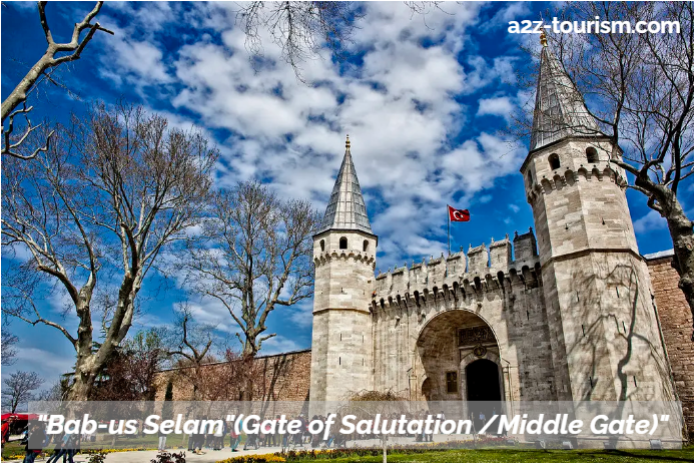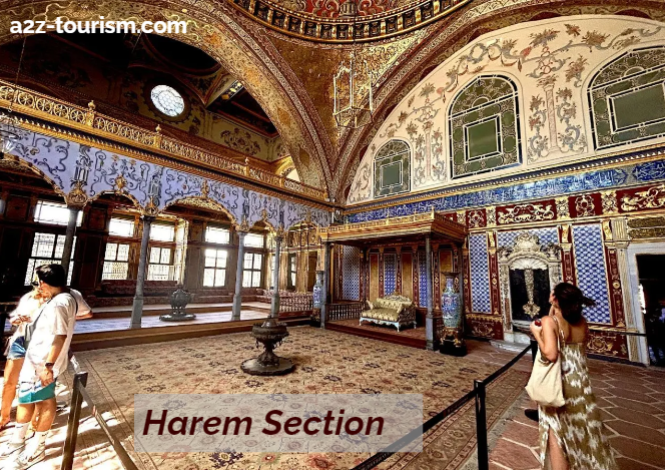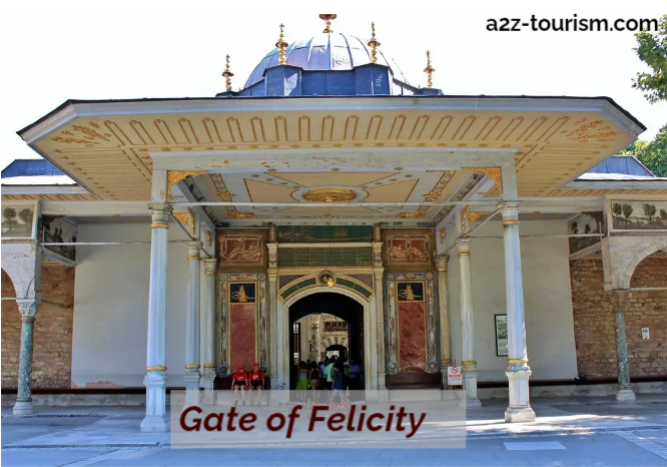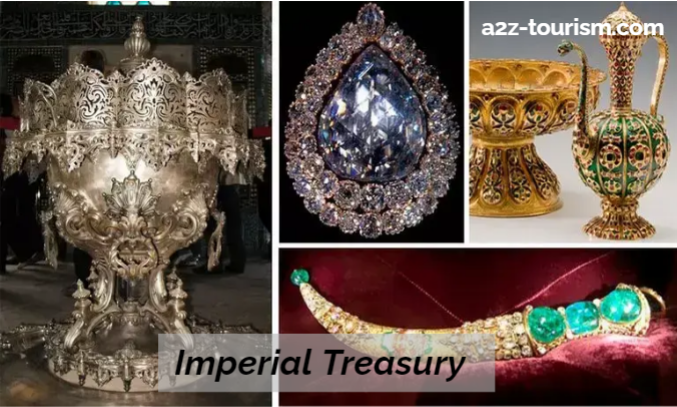The Ottoman Imperial Palace, known as Topkapı Palace Museum( Topkapı Sarayı), served as the primary hearthstone and executive center for the Ottoman sultans. Within its walls, a shade of witching tales awaits, surpassing the collaborative appeal of utmost galleries worldwide. This majestic palace, dating from the 15th to the 19th centuries, was the vibrant mecca of the Ottoman conglomerate, where lascivious sultans, ambitious courtiers, alluring doxies, and cunning eunuchs abided and conducted their affairs. Exploring the opulent belvederes, treasure-laden Treasury, and extensive Stew within the palace complex offers a witching regard into the intricate lives they led.

It has numerous exhibition halls, a Treasury section, and a Harem.
Mehmet the Conqueror laid the foundation of the palace shortly after the Conquest in 1453, and it remained his hearthstone until he died in 1481. consecutive sultans continued to inhabit this prestigious complex until the 19th century when they decided on extravagant European-style palaces along the Bosphorus. Before stepping through the Imperial Gate( Bab- ı Hümayun), take a moment to respect the rococo-style root of Sultan Ahmet III, erected in 1728, which stands in the cobbled forecourt just outdoors. The main ticket office is located in the First Court, marking the entrance to the palace’s witching exhibition halls, Treasury section, and the charming Harem.
Topkapı Palace Museum was home to all the Ottoman sultans until the reign of Abdulmecid I( 1839- 1860), a period of nearly four centuries.

First Court
Upon passing through the Imperial Gate, you’ll find yourself in the First Court, also appertained to as the Court of the Janissaries or the Parade Court. As you explore this area, the first notable monument on your left wing is the Hagia Irene Museum. Firstly the intricate church is extensively honored as Aya İrini. conterminous to it’s the former Imperial Mint, known as the Currency Imperial Ottoman Administration or Meskûkât- ı Şâhâne, which was constructed in 1727 and latterly renamed after the Tanzimat Reform. These structures bear substantiation to the rich literal shade woven within the palace grounds, inviting you to claw deeper into the witching stories of the Ottoman Empire.
Second Court
The Middle Gate, also known as Ortakapı or Bab- üs Selâm, served as the entrance to the Second Court of the palace, which was devoted to the executive affairs of the conglomerate. During the time of the Ottoman Empire, only the sultan and the valide sultan, the mama of the sultan, were permitted to pass through the Middle Gate on horseback. Others, including the grand vizier, were needed to dismount. This gate symbolized the distinction and honor bestowed upon the ruling elite.
The Second Court of Topkapı Palace offers a graphic and demesne-like setting. Unlike the conventional European palaces characterized by a single central structure girdled by auditoriums, Topkapı Palace is an assemblage of belvederes, kitchens, barracks, followership chambers, alcoves, and sleeping diggings arranged around a central quadrangle. As you enter, the Great Palace Kitchens on the right( east) side allure with their majesty. Among them is the devoted Helvahane, a confectionary kitchen. Interestingly, these kitchens house a small portion of Topkapı’s expansive collection of Chinese celadon demitasse, treasured by the sultans not only for its beauty but also for the belief that it would change color if it came into contact with poisoned food.
On the left wing( west) side of the Second Court stands the ornate Imperial Council Chamber, known as Dîvân- ı Hümâyûn. This esteemed chamber served as a meeting place for the council to bandy state matters, while the sultan sometimes heeded in through a gold tulle deposited grandly on the wall. conterminous to it’s a room that showcases a multifariousness of timepieces from the palace’s remarkable collection.
Towards the north of the Imperial Council Chamber lies the external Treasury, where a remarkable display of Ottoman and European arms and armor awaits. This treasury serves as a testament to the empire’s military prowess and showcases a different array of artillery and protective gear.
Exploring the Second Court of Topkapı Palace offers a glimpse into the empire’s executive workings, as well as the substance and strategic considerations that shaped the diurnal lives and decisions of the Ottoman rulers.

Harem Section
Beneath the Tower of Justice on the western side of the Second Court, you will find the entrance to the Harem. If you choose to visit this interesting section of the palace – and we largely recommend that you do – please note that a devoted ticket is needed. It’s worth mentioning that the caller’s route through the Harem may vary depending on restoration or stabilization work, and certain areas mentioned then might not be accessible during your visit.
Contrary to popular belief, the Harem wasn’t solely a place for the sultan’s indulgence and debauchery. In reality, it served as the living diggings for the Homeric family, with every aspect of Harem life governed by tradition, duty, and form. The term” stew” itself translates to” interdicted” or” private.”
The Stew accommodated as numerous as 300 doxies, although the factual figures frequently remained lower. Upon entering the Harem, the youthful girls would admit an education in Islam, Turkish culture, and language, as well as colorful trades similar to makeup, dress, form, music, reading, jotting, embroidery, and cotillion. They would progress through a merit-grounded system, originally serving as ladies- in staying to the sultan’s doxies and children, also to the valide sultan, and ultimately, if particularly seductive and talented, to the sultan himself.
According to Islamic law, the sultan could have four licit women, known as kadın( woman ). still, she was referred to as Haseki sultan, while a son-bearing woman was called Haseki kadın If a woman bore a son. Governing the Harem was the valide sultan, who held considerable influence over the sultan, his women, doxies, and matters of state. frequently, the valide sultan possessed expansive land estates in her name and managed them through black eunuch retainers, who held significant power and could bear orders directly to the grand vizier.
The Harem’s construction began during the reign of Murat III( 1574 – 1595), with the before seraglios of former sultans located in the now- -now-now-demolished Eski Sarayı( Old Palace) near present-day Beyazıt Meydanı.
The Harem complex consists of six bottoms, with only one accessible to visitors. This section is handed through the Carriage Gate. conterminous to the gate is the Dormitory of the Corps of the Palace Guards, a strictly restored two-story structure adorned with magnific 16th- and 17th-century İznik penstocks. Inside the gate lies the Dome with Cupboards, the Harem storeroom where fiscal records were maintained. Beyond it stands the Hall with the Fountain, featuring exquisite Kütahya penstocks from the 17th century, depicting botanical motifs and eulogies from the Quran. The hall also houses a marble steed-mounting block formerly employed by the sultans. Connected to it’s the Mosque of the Black Eunuchs, adorned with 17th-century penstocks depicting scenes from Mecca.
Continuing from this point is the Courtyard of the Black Eunuchs, stretched with Kütahya penstocks. Behind the marble galilee on the left side are the Black Eunuchs’ Dormitories. originally, white eunuchs were employed, but later, black eunuchs transferred as gifts by the Ottoman governor of Egypt assumed control. Up to 200 black eunuchs abided then, guarding the Harem’s entrances and attending to the women.
At the far end of the yard stands the Main Gate into the Harem, accompanied by a guard room showcasing two enormous bejeweled glasses. From then, the Doxies’ Corridor leads to the Courtyard of the Doxies and Sultan’s Consorts, girdled by cataracts, a laundry room, a laundry area, dormitories, and private apartments.
Opposite the yard, across the Doxies’ Corridor, is a room adorned with a tiled chimney stack, followed by the Apartments of the Valide Sultan, serving as the central seat of power within the Harem. From these lavishly decorated apartments, the valide sultan oversaw and managed her vast” family.” Noteworthy among them is the Salon of the Valide Sultan, featuring pleasurable 19th-century showpieces depicting tranquil views of Istanbul, as well as a beautiful double hamam dating back to 1585, with bejeweled citation rails added at an afterdate.
Beyond the Courtyard of the Valide Sultan awaits a splendid event room with a grand fireplace, leading to an entranceway adorned with Kütahya and İznik penstocks from the 17th century. This was the staging area for tycoons, valid sultans, and elderly doxies before entering the elegant Imperial Hall for a followership with the sultan. erected during the reign of Murat III, the hall was later redecorated in a baroque style during the reign of Osman III( 1754 – 1757).
conterminous to it was the Privy Chamber of Murat III, considered one of the most opulent apartments in the palace. Dating back to 1578, the maturity of its decorations is original and is believed to be the work of Sinan, a famed mastermind of the Ottoman Empire. The strictly restored three-tiered marble root was designed to produce the sound of slinging water and to help wiretap the sultan’s exchanges. The bejeweled canopied seating areas were added in the 18th century.
Coming to the Privy Chamber of Murat III is the Privy Chamber of Ahmet III, accompanied by a touching dining room constructed in 1705. The dining room features wooden panels decorated with lacquered images of flowers and fruits.
Returning through the Privy Chamber of Murat III, you will encounter two of the most exquisite apartments in the Stew – the Twin Kiosk/ Apartments of the Crown Prince. These apartments, dating back to around 1600, show a painted oil pipe in the first room and fine İznik pipe panels above the fireplace in the alternate room. The stained glass windows are also memorable. Beyond these apartments lies the Courtyard of the Favourites. As you peer over the edge of the yard, suggesting a sundeck, you will notice a large empty pool. Above the yard, you will see the small windows of several dimly lit apartments, comprising the kafes( pen), where the sultan’s sisters or sons were frequently confined. conterminous to it’s the Harem Mosque adorned with penstocks, featuring a baroque mihrab( a niche in a minaret indicating the direction of Mecca). From then, you can follow the passage known as the Golden Road and exit into the palace’s Third Court.

Third Court
The Third Court is entered through the Gate of Felicity. The sultan’s private sphere was staffed and guarded by white eunuchs. Inside is the followership Chamber, constructed in the 16th century but refurbished in the 18th century. Important officers and foreign ministers were brought to this little pavilion to conduct the high business of the state. The Sultan, seated on a huge Chesterfield, audited the ministers’ gifts and immolations as they were passed through the doorway on the left wing. Right behind the Audience Chamber is the suitable Library of Ahmet III, erected in 1719.
On the eastern edge of the Third Court is the Dormitory of the Expeditionary Force, which was closed for restoration at the time of exploration. When it reopens it’ll house the palace’s rich collection of Homeric blankets, kaftans, and uniforms worked in tableware and gold thread. On the other side of the Third Court are the Sacred Safekeeping Apartments. These apartments, extravagantly decorated with İznik penstocks, house numerous bones of the Prophet. When the sultans lived then, the apartments were opened only formerly a time, for the Homeric family to pay homage to the memory of the Prophet on the 15th day of the holy month of Ramazan. Next to the sacred keeping Apartments is the Dormitory of the Privy Chamber, which houses an exhibition of pictures of 36 sultans. The highlight is an awful oil of the Enthronement Ceremony of Sultan Selim III( 1789) by Konstantin Kapidagli.

Imperial Treasury at Topkapı Palace
The Imperial Treasury, located on the eastern edge of the Third Court in Topkapı Palace, is home to a remarkable collection of objects adorned with precious accouterments similar to gold, tableware, rubies, emeralds, wanton, plums, and diamonds. The storeroom erection itself dates back to 1460, during the reign of Mehmet the Conqueror, and first served as event apartments. Although it may have been closed for restoration during your last visit, it’s worth exploring when it reopens.
When you visit the Treasury, make sure to look out for two notable pieces the jewel-crusted Sword of Süleyman the Magnific and the extraordinary Throne of Ahmed I, also known as the Arife Throne. The Throne of Ahmed I is particularly remarkable as it features intricate mama-of-plum inlay and was designed by Sedefhar Mehmet Ağa, the mastermind of the Blue Mosque. Another highlight of the Treasury is the notorious Topkapı Dagger, which gained notoriety through its definition in Jules Dassin’s 1964 film” Topkapı.” The dagger is adorned with three enormous emeralds on its bow and indeed includes a watch set into the pommel. also, do not miss the Kasıkçı( Spoonmaker’s) Diamond, a teardrop-shaped 86-carat diamond girdled by multitudinous lower monuments. This diamond was first worn by Mehmet IV during his accession to the throne in 1648.
Fourth Court Pleasure Belvederes
The Fourth Court of Topkapı Palace is home to several pleasure belvederes. Among them is the Mecidiye Kiosk, constructed during the reign of Abdül Mecit( 1839 – 1861) and designed grounded on 19th-century European models. hard, you will find the Head Physician’s Pavilion, an interesting structure given that the head croaker was always one of the sultan’s Jewish subjects. Also located on this sundeck is the pavilion of Mustafa Pasha, occasionally appertained to as the Sofa Köşkü. During the reign of Ahmet III, the Tulip Garden girding this pavilion was filled with the rearmost kinds of tulips, reflecting the fashionability of tulip civilization during the Tulip period.
As you lift the stairs at the end of the Tulip Garden, you will reach the Marble Terrace, which features an ornamental pool, three belvederes, and the capricious İftariye Kameriyesi. This small structure was commissioned by İbrahim I, also known as” the Crazy,” in 1640 as a graphic place to break the fast during the holy month of Ramazan. Another notable kiosk in this area is the Revan Kiosk, erected by Murat IV in 1636 to commemorate the Ottoman Empire’s recovery of the megacity of Yerevan( now in Armenia) from Persia. also, the Baghdad Kiosk, constructed in 1639 by Murat IV, stands as one of the last exemplifications of classical palace armature. Its exquisite features include İznik penstocks, a painted ceiling, and mama-of-plum and tortoiseshell inlay. The small Circumcision Room( Sünnet Odası), erected by İbrahim I in 1640, was used for the ritual that marked the transition of Muslim boys into masculinity, and its external walls are adorned with particularly beautiful pipe panels.
Visiting Information
Position Topkapı Palace Museum is positioned on the Sarayburnu( Seraglio Point), overlooking the Marmara Sea and the Bosphorus Strait in the literal promontory( Fatih District) of İstanbul.
How to Get to Topkapı Palace
The most accessible way to reach the Sultanahmet area, where Topkapı Palace is located, is via the T1 wagonette line( Wagonette 1). It’s a short 5- 5-nanosecond walk from both Sultanahmet and Gulhane wagonette stations to Topkapı Palace. The distance from Gulhane wagonette station to the gallery is only 600 measures, while from Sultanahmet wagonette station, it’s 700 measures, leading you to the Homeric gate and the first yard of Topkapı Palace.
Facilities, Services, Tips, and Rules
- impaired access is possible, but wheelchairs aren’t handed, and the cobblestone-covered hills may pose challenges for hindered trippers.
- There’s no parking installation within the palace demesne.
- Photography isn’t allowed inside the gallery halls.
- Children below the age of 6 can enter for free.
- Entrance is free of charge for impaired callers and one companion who’s a first-degree relative.
- It’s recommended to use audio attendants or hire particular attendants to completely appreciate the palace’s intricate details.
- The security check ranges at the Imperial gate can be long, but you can enter the first yard from the Archaeology Museum via a steep path through Gülhane Park.
Smoking( Continued)
Smoking, counting electronic cigarettes, is thoroughly prohibited all through the whole demesne of the display to assist certain fire occurrences and to guarantee the consolation of other callers. Smoking in open ranges was prohibited by Law No. 4207 in Turkey on November 7, 1996.
A few of the smart impacts to find in Topkapı Royal residence incorporate its broad collections of demitasse, covers, weapons, Hassock models, Islamic calligraphic calligraphies, and other Hassock treasures and gems. Make beyond any doubt to visit the Royal Residence Treasury, which houses an intriguing collection of the world’s most infamous and marvelous gems, including the renowned worldwide Topkapı Dagger. This blade picked up notoriety through its definition within the film” Topkapı.”
Conclusion
Topkapı Palace Museum, established by Mehmet the Conqueror in the 15th century, served as the magnificent hearthstone and executive center of the Ottoman sultans for centuries. Its architectural splendor is apparent in the belvederes, kitchens, barracks, and followership chambers arranged around yards and auditoriums. The palace’s significance goes beyond its grandeur, as it holds the rich heritage of the Ottoman Empire, including the Harem, the sultan’s private domain, and the Imperial Treasury with its glowing collection of jewels. Topkapı Palace is a captivating destination that offers a glimpse into the Homeric history and the individualities who formerly inhabited its halls.
FAQs
Why is Topkapi notorious?
Topkapi Palace is notorious for being the magnific hearthstone and executive center of the Ottoman sultans. It holds significant historical and artistic value, showcasing centuries of imperial history and intrigue within its walls.
What does Topkapi mean in Turkish?
” Topkapi” translates to” Cannon Gate” in Turkish. The name derives from the gate located at the palace’s accession.
Is Topkapı Palace worth it?
Topkapı Palace is surely worth visiting, especially for history suckers and artistic explorers. It offers a one-off opportunity to claw into the opulent world of the Ottoman Empire, explore its splendid architecture, and discover the stories of the individuals who lived there.
How important is it bring to visit Topkapı Palace?
The cost of visiting Topkapı Palace can vary. It’s judicious to check the sanctioned website or communicate with the palace directly for the most up-to-date information on ticket prices and any implicit abatements for different caller orders.
Can you enter Topkapi Palace for free?
Generally, entrance to Topkapı Palace isn’t free. There’s an admission fee to explore the palace and its various sections. still, there might be certain days or times when abatements or elevations are available, so it’s recommended to check the sanctioned website or interrogate beforehand.
What day is Topkapi Palace closed?
As of my knowledge arrestment in September 2021, Topkapı Palace is closed on Tuesdays. still, it’s judicious to corroborate this information as schedules and opening hours might change. Checking the sanctioned website or reaching the palace directly will give the most accurate and over-to-date information regarding its check days.

